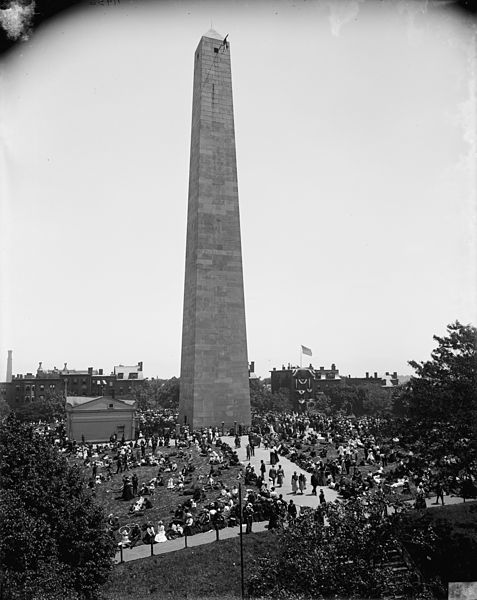
The Bunker Hill Monument. Photo by deek ay (CC BY 2.0) https://www.flickr.com/photos/69392382@N04/22077318925/in/photostream/ 
The monument as seen from the harbor. jlamark / CC BY-SA (https://creativecommons.org/licenses/by-sa/4.0) 
Bunker Hill Monument. Bunker Hill Day, Boston, Charlestown, Massachusetts between 1890 and 1901. Publisher: Detroit Publishing Co. Repository: Library of Congress Prints and Photographs Division Washington, D.C. 20540 USA. https://www.loc.gov Public Domain.
https://upload.wikimedia.org/wikipedia/commons/0/0c/Bunker_hill_monument.jpg
Stone Chips collected by Reeve.
- Stone chips from Bunker Hill monument, 42.3764° N, 71.0608° W.
These small grey granite fragments were collected by General Reeve during a trip to Massachusetts from the monument for the Battle of Bunker Hill, which was an important battle during the American Revolutionary War.
The Battle of Bunker Hill was fought on Breeds Hill during the American Revolutionary War on June 17, 1775, and its outcome changes the direction of the war. Seeking to take back control of the city of Boston and prevent the British from seizing anymore land around the city, American forces set up an encampment overnight, across the river near the town of Charleston. Breed’s Hill was likely chosen instead of the originally planned Bunker Hill due to its proximity to the city of Boston and view of the harbor. Spotted in the morning by British ships, fighting ensued. The long battle ended with an American defeat yet was a decisive point in the war, as the British suffered substantial losses.
Construction on the monument began on June, 17, 1825, the fiftieth anniversary of the battle. The monument was dedicated on the same day in 1843, marking it’s completion. Made entirely from granite from nearby Quincy, it is an obelisk that stands 67 meters (221 feet) tall. It stands at the top of Breed’s Hill in the center of a small park, which is now encircled by a road and numerous houses.
This monument necessitated the creation of one of the first railways in the United States. The Granite Railway was constructed between quarries in Quincy, Massachusetts and a nearby dock on the Neponset River so they could be transported to the construction site.
Further Reading:
- Ellis, George Edward. 1895. History of the Battle of Bunker’s [Breed’s] Hill, on June 17, 1775. Boston, MA: Lee & Shepard.
- Frothingham, Richard. 1872. History of the Siege of Boston, and of the Battles of Lexington, Concord, and Bunker Hill: Also an Account of the Bunker Hill Monument. 3Rd ed. Boston, MA: Little, Brown.
- Morton, Joseph C. 2003. The American Revolution. Westport, Conn.: Greenwood Press.